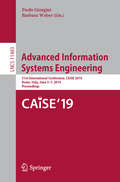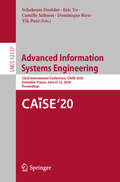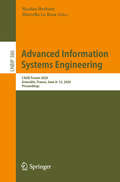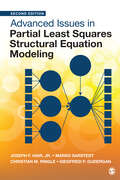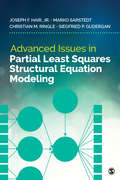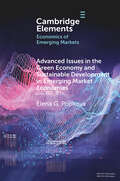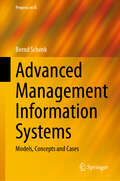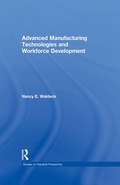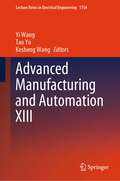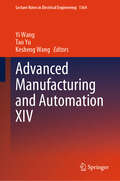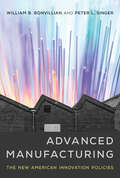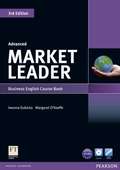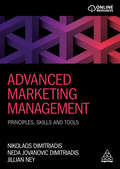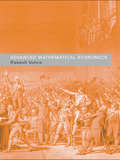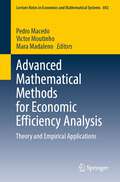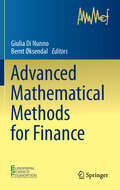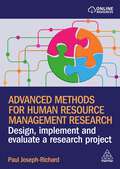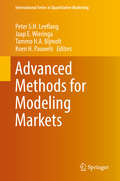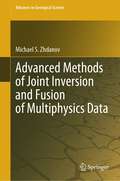- Table View
- List View
Advanced Information Systems Engineering: 31st International Conference, CAiSE 2019, Rome, Italy, June 3–7, 2019, Proceedings (Lecture Notes in Computer Science #11483)
by Barbara Weber Paolo GiorginiThis book constitutes the refereed proceedings of the 31st International Conference on Advanced Information Systems Engineering, CAiSE 2019, held in Rome, Italy, in June 2019. The 41 full papers presented in this volume were carefully reviewed and selected from 206 submissions. The book also contains one invited talk in full paper length. The papers were organized in topical sections named: information system engineering; requirements and modeling; data modeling and analysis; business process modeling and engineering; information system security; and learning and mining in information systems. Abstracts on the CAiSE 2019 tutorials can be found in the back matter of the volume.
Advanced Information Systems Engineering: 32nd International Conference, CAiSE 2020, Grenoble, France, June 8–12, 2020, Proceedings (Lecture Notes in Computer Science #12127)
by Schahram Dustdar Camille Salinesi Eric Yu Dominique Rieu Vik PantThis book constitutes the refereed proceedings of the 32nd International Conference on Advanced Information Systems Engineering, CAiSE 2020, held in Grenoble, France, in June 2020.* The 33 full papers presented in this volume were carefully reviewed and selected from 185 submissions. The book also contains one invited talk in full paper length. The papers were organized in topical sections named: distributed applications; AI and big data in IS; process mining and analysis; requirements and modeling; and information systems engineering. Abstracts on the CAiSE 2020 tutorials can be found in the back matter of the volume.*The conference was held virtually due to the COVID-19 pandemic.
Advanced Information Systems Engineering: CAiSE Forum 2020, Grenoble, France, June 8–12, 2020, Proceedings (Lecture Notes in Business Information Processing #386)
by Marcello La Rosa Nicolas HerbautThis book constitutes the thoroughly refereed proceedings of the CAiSE Forum 2020 which was held as part of the 32nd International Conference on Advanced Information Systems Engineering, CAiSE 2020, in June 2020. The conference was held virtually due to the COVID-19 pandemic. The CAiSE Forum is a place within the CAiSE conference for presenting and discussing new ideas and tools related to information systems engineering. Intended to serve as an interactive platform, the Forum aims at the presentation of emerging new topics and controversial positions, as well as demonstration of innovative systems, tools and applications. This year’s theme was “Responsible Information Systems”. The 12 full papers presented in this volume were carefully reviewed and selected from 19 submissions.
Advanced Issues in Partial Least Squares Structural Equation Modeling
by Marko Sarstedt Christian M. Ringle Joe Hair Siegfried P. GuderganThe Second Edition of Advanced Issues in Partial Least Squares Structural Equation Modeling offers a straightforward and practical guide to PLS-SEM for users ready to go further than the basics of A Primer on Partial Least Squares Structural Equation Modeling, Third Edition. Even in this advanced guide, the authors have limited the emphasis on equations, formulas, and Greek symbols, and instead rely on detailed explanations of the fundamentals of PLS-SEM and provide general guidelines for understanding and evaluating the results of applying the method. A single study on corporate reputation features as an example throughout the book, along with a single software package (SmartPLS 4.0) to provide a seamless learning experience. The approach of this book is based on the authors’ many years of conducting research and teaching methodology courses, including developing the SmartPLS software. The preparation of the book, especially this new edition, is based on the authors’ desire to communicate the PLS-SEM method to a much broader audience from management and marketing to engineering, geography, medicine, political and environmental sciences, psychology, and beyond. The Second Edition includes a new chapter on the necessary condition analysis (NCA) and covers the most recent developments in PLS-SEM, with detailed guidelines for estimating and validating higher-order constructs and nonlinear effects as well as more insights on multigroup and latent class analyses using FIMIX-PLS and PLS-POS. The book is aimed at researchers and practitioners who seek to gain comprehensive knowledge of more advanced PLS-SEM methods.
Advanced Issues in Partial Least Squares Structural Equation Modeling
by Marko Sarstedt Christian M. Ringle Joe Hair Siegfried P. GuderganThe Second Edition of Advanced Issues in Partial Least Squares Structural Equation Modeling offers a straightforward and practical guide to PLS-SEM for users ready to go further than the basics of A Primer on Partial Least Squares Structural Equation Modeling, Third Edition. Even in this advanced guide, the authors have limited the emphasis on equations, formulas, and Greek symbols, and instead rely on detailed explanations of the fundamentals of PLS-SEM and provide general guidelines for understanding and evaluating the results of applying the method. A single study on corporate reputation features as an example throughout the book, along with a single software package (SmartPLS 4.0) to provide a seamless learning experience. The approach of this book is based on the authors’ many years of conducting research and teaching methodology courses, including developing the SmartPLS software. The preparation of the book, especially this new edition, is based on the authors’ desire to communicate the PLS-SEM method to a much broader audience from management and marketing to engineering, geography, medicine, political and environmental sciences, psychology, and beyond. The Second Edition includes a new chapter on the necessary condition analysis (NCA) and covers the most recent developments in PLS-SEM, with detailed guidelines for estimating and validating higher-order constructs and nonlinear effects as well as more insights on multigroup and latent class analyses using FIMIX-PLS and PLS-POS. The book is aimed at researchers and practitioners who seek to gain comprehensive knowledge of more advanced PLS-SEM methods.
Advanced Issues in Partial Least Squares Structural Equation Modeling
by Marko Sarstedt Dr Joe Hair Dr Christian M. Ringle Dr Siegfried P. GuderganWritten as an extension of A Primer on Partial Least Squares Structural Equation Modeling (PLS-SEM) Second Edition, this easy-to-understand, practical guide covers advanced content on PLS-SEM to help students and researchers apply techniques to research problems and accurately interpret results. Authors Joseph F. Hair, Jr., Marko Sarstedt, Christian Ringle, and Siegfried P. Gudergan provide a brief overview of basic concepts before moving to the more advanced material. Offering extensive examples on SmartPLS 3 software and accompanied by free downloadable data sets, the book emphasizes that any advanced PLS-SEM approach should be carefully applied to ensure that it fits the appropriate research context and the data characteristics that underpin the research.
Advanced Issues in Partial Least Squares Structural Equation Modeling
by Marko Sarstedt Dr Joe Hair Dr Christian M. Ringle Dr Siegfried P. GuderganWritten as an extension of A Primer on Partial Least Squares Structural Equation Modeling (PLS-SEM) Second Edition, this easy-to-understand, practical guide covers advanced content on PLS-SEM to help students and researchers apply techniques to research problems and accurately interpret results. Authors Joseph F. Hair, Jr., Marko Sarstedt, Christian Ringle, and Siegfried P. Gudergan provide a brief overview of basic concepts before moving to the more advanced material. Offering extensive examples on SmartPLS 3 software and accompanied by free downloadable data sets, the book emphasizes that any advanced PLS-SEM approach should be carefully applied to ensure that it fits the appropriate research context and the data characteristics that underpin the research.
Advanced Issues in Property Valuation
by Hans Lind Bo NordlundDiscover an insightful new text covering advanced problems in real property valuation In Advanced Issues in Property Valuation, real estate valuation experts and authors Hans Lind and Bo Nordlund provide a deep understanding of the concepts, theories, methods and controversies in property valuation. The book introduces readers to controversies and discussions in real estate valuation, including the relevance of market value for valuation for lending purposes, how uncertainty in property valuations should be interpreted, and the relationship between market value and fair value in financial reporting. Readers will also benefit from the inclusion of: A thorough introduction to the concepts, theories, methods and problems in real estate property valuation An exploration of the relevance of market value for valuation for lending purposes A practical discussion of how uncertainty in property valuations should be interpreted A concise treatment of the relationship between market value and fair value in financial reporting An examination of how concerns about sustainability and other structural changes can affect property valuation Perfect for graduate level students in courses involving valuation or real estate, Advanced Issues in Property Valuation is also an excellent resource for real estate practitioners who wish to update and deepen their knowledge about property valuation.
Advanced Issues in the Green Economy and Sustainable Development in Emerging Market Economies (Elements in the Economics of Emerging Markets)
by Elena G. PopkovaThis Element goes far beyond economic theory. It will also be of interest to representatives of the environmental sciences due to its focus on the “green” economy and sustainable development. It will also be interesting to the representatives of the social sciences, as it takes into account the peculiarities of emerging market economies. Learning from the COVID-19 pandemic makes this Element interesting from a health economics perspective.
Advanced Leadership Field Perspectives: Detroit
by Rosabeth Moss Kanter Ai-Ling Jamila MaloneIndustry and Background Note
Advanced Leadership Field Perspectives: Shanghai
by William C. Kirby Erica M ZendellIndustry and Background Note
Advanced Management Information Systems: Models, Concepts and Cases (Progress in IS)
by Bernd SchenkThis is a textbook for advanced courses on Management Information Systems (MIS). It bridges the gap between theoretical frameworks and practical applications, offering insights into both foundational principles and emerging trends. Covering topics such as artificial intelligence, data analytics, enterprise architecture, and information systems governance, the book explores the multifaceted nature of MIS and its transformative impact on modern organizations. Each chapter integrates foundational IS research with the latest insights, applying these to case studies to ensure both relevance and academic rigor. Topics include business-IT alignment, data-driven decision-making, and the ethical challenges of managing information systems in today&’s complex, interconnected world. Through a combination of theoretical models, practical frameworks, and real-world examples, this book equips readers with the tools needed to navigate the evolving MIS landscape. The book is designed for advanced learners, building upon foundational MIS concepts to provide deeper insights into the field. It is particularly valuable for students pursuing a bachelor&’s degree in Information Systems or related disciplines, as well as for those enrolled in master&’s programs focused on IS. Additionally, professionals looking to enhance their expertise will find this book a useful resource. Since it does not cover introductory topics in detail, a basic understanding of the field of information systems is recommended for fully engaging with the material.
Advanced Manufacturing Technologies and Workforce Development (Studies on Industrial Productivity: Selected Works)
by Nancy E. WaldeckFirst Published in 2000. Routledge is an imprint of Taylor & Francis, an informa company.
Advanced Manufacturing and Automation XIII (Lecture Notes in Electrical Engineering #1154)
by Yi Wang Kesheng Wang Tao YuThe book is a compilation of selected papers from the 13th International Workshop of Advanced Manufacturing and Automation (IWAMA 2023), held in Shanghai University of Engineering Science, China on 15 - 16 October, 2023. Topics focusing on novel techniques for manufacturing and automation in Industry 4.0 are now vital factors for the maintenance and improvement of the economy of a nation and the quality of life. It will help academic researchers and engineers to implement the concept, theory and methods in Industry 4.0 which has been a hot topic. These proceedings will make valuable contributions to academic researchers, engineers in the industry for the challenges in the 4th industry revolution and smart factories.
Advanced Manufacturing and Automation XIV (Lecture Notes in Electrical Engineering #1364)
by Yi Wang Kesheng Wang Tao YuThe book is a compilation of selected papers from the 14th International Workshop of Advanced Manufacturing and Automation (IWAMA 2024), held in Kunming University of Science and Technology, China on 11-12 October, 2024. Topics focusing on novel techniques for manufacturing and automation in Industry 4.0 are now vital factors for the maintenance and improvement of the economy of a nation and the quality of life. It will help academic researchers and engineering to implement the concept, theory and methods in Industry 4.0 which has been a hot topic. These proceedings will make valuable contributions to academic researchers, engineers in the industry for the challenges in the 4th industry revolution and smart factories.
Advanced Manufacturing: The New American Innovation Policies (The\mit Press Ser. #Vol. 1)
by William B. Bonvillian Peter L. SingerHow to rethink innovation and revitalize America's declining manufacturing sector by encouraging advanced manufacturing, bringing innovative technologies into the production process.The United States lost almost one-third of its manufacturing jobs between 2000 and 2010. As higher-paying manufacturing jobs are replaced by lower-paying service jobs, income inequality has been approaching third world levels. In particular, between 1990 and 2013, the median income of men without high school diplomas fell by an astonishing 20% between 1990 and 2013, and that of men with high school diplomas or some college fell by a painful 13%. Innovation has been left largely to software and IT startups, and increasingly U.S. firms operate on a system of “innovate here/produce there,” leaving the manufacturing sector behind. In this book, William Bonvillian and Peter Singer explore how to rethink innovation and revitalize America's declining manufacturing sector. They argue that advanced manufacturing, which employs such innovative technologies as 3-D printing, advanced material, photonics, and robotics in the production process, is the key.Bonvillian and Singer discuss transformative new production paradigms that could drive up efficiency and drive down costs, describe the new processes and business models that must accompany them, and explore alternative funding methods for startups that must manufacture. They examine the varied attitudes of mainstream economics toward manufacturing, the post-Great Recession policy focus on advanced manufacturing, and lessons from the new advanced manufacturing institutes. They consider the problem of “startup scaleup,” possible new models for training workers, and the role of manufacturing in addressing “secular stagnation” in innovation, growth, the middle classes, productivity rates, and related investment. As recent political turmoil shows, the stakes could not be higher.
Advanced Market Leader: Business Leader Course Book 3rd edition
by Iwonna Dubicka Margaret O'Keeffe'Market Leader' is the major business English course for tomorrow's business leaders. Incorporating material from the Financial Times, it brings real business issues right into the classroom.
Advanced Marketing Management: Principles, Skills and Tools
by Dr Nikolaos Dimitriadis Neda Jovanovic Dimitriadis Dr Jillian NeyMarketing as a practice is facing unprecedented challenges: a changing media landscape, an increasingly complex customer journey, innovative technologies, start-ups which disrupt traditional channels and a new generation of tech-savvy clients. How should students and practitioners adapt to this shifting landscape and address the skills gap that many of today's marketers face? Advanced Marketing Management prepares students for this new world of marketing. Since traditional marketing approaches fail to provide convincing solutions to modern business realities, a new approach is urgently needed if marketers are to regain trust within their organizations. Using contemporary examples, business case studies and supporting pedagogy, Advanced Marketing Management will provide a critical exploration into the more advanced aspects of marketing management, including the gap that exists between formal marketing literature and real-world practice, discussion of multidisciplinary tools, and the crucial evolution of the '4Ps'. Summarizing a large body of literature and academic research on new developments, this book is the go-to guide for students, lecturers and practitioners, wanting to succeed as modern marketers.
Advanced Mathematical Economics (Routledge Advanced Texts in Economics and Finance)
by Rakesh V. VohraThis concise textbook presents students with all they need for advancing in mathematical economics. Detailed yet student-friendly, Vohra's book contains chapters in, amongst others: * Feasibility * Convex Sets * Linear and Non-linear Programming* Lattices and Supermodularity. Higher level undergraduates as well as postgraduate students in mathematical economics will find this book extremely useful in their development as economists.
Advanced Mathematical Methods for Economic Efficiency Analysis: Theory and Empirical Applications (Lecture Notes in Economics and Mathematical Systems #692)
by Pedro Macedo Victor Moutinho Mara MadalenoEconomic efficiency analysis has received considerable worldwide attention in the last few decades, with Stochastic Frontier Analysis (SFA) and Data Envelopment Analysis (DEA) establishing themselves as the two dominant approaches in the literature. This book, by combining cutting-edge theoretical research on DEA and SFA with attractive real-world applications, offers a valuable asset for professors, students, researchers, and professionals working in all branches of economic efficiency analysis, as well as those concerned with the corresponding economic policies. The book is divided into three parts, the first of which is devoted to basic concepts, making the content self-contained. The second is devoted to DEA, and the third to SFA. The topics covered in Part 2 range from stochastic DEA to multidirectional dynamic inefficiency analysis, including directional distance functions, the elimination and choice translating algorithm, benefit-of-the-doubt composite indicators, and internal benchmarking for efficiency evaluations. Part 3 also includes exciting and cutting-edge theoretical research on e.g. robustness, nonparametric stochastic frontier models, hierarchical panel data models, and estimation methods like corrected ordinary least squares and maximum entropy.
Advanced Mathematical Methods for Finance
by Giulia Di Nunno Bernt ØksendalThis book presents innovations in the mathematical foundations of financial analysis and numerical methods for finance and applications to the modeling of risk. The topics selected include measures of risk, credit contagion, insider trading, information in finance, stochastic control and its applications to portfolio choices and liquidation, models of liquidity, pricing, and hedging. The models presented are based on the use of Brownian motion, Lévy processes and jump diffusions. Moreover, fractional Brownian motion and ambit processes are also introduced at various levels. The chosen blend of topics gives an overview of the frontiers of mathematics for finance. New results, new methods and new models are all introduced in different forms according to the subject. Additionally, the existing literature on the topic is reviewed. The diversity of the topics makes the book suitable for graduate students, researchers and practitioners in the areas of financial modeling and quantitative finance. The chapters will also be of interest to experts in the financial market interested in new methods and products. This volume presents the results of the European ESF research networking program Advanced Mathematical Methods for Finance.
Advanced Medical Technology Corp.
by Thomas R. Piper Steven RogersA loan officer must decide whether to lend $8 million to a rapidly growing high technology company. The company has had a series of relationships with three other banks. Reports from loan officers at these banks are mixed and raise questions as to the ease with which a relationship would proceed. The full range of issues must be considered in evaluating the credit worthiness (character, collateral, capacity, conditions, pricing). The loan officer must also determine how much weight to place on a comfort letter from a major pharmaceutical firm.
Advanced Methods for Human Resource Management Research: Design, Implement and Evaluate a Research Project
by Paul Joseph-RichardUnderstanding and applying research methods is a key skill in human resource management. This new textbook shows how to successfully complete a research project across the HR function.Advanced Methods for Human Resource Management Research provides a practice-based approach to planning and implementing research projects. Each chapter focuses on one HRM practice and a 'Method in Focus' feature that shows how a particular method could be used for researching that practice. This enables postgraduate Research Methods students to gain an understanding of how research may be most effectively conducted for different aspects of HR, from recruitment, selection and people analytics to learning and development, sustainable HRM and employee wellbeing.This book offers comprehensive guidance on what kinds of questions can be asked and the application of current designs and methods. Readers will learn how to conduct both qualitative and quantitative research, such as interviews and literature reviews, using Big Data, social media and visuals, as well as creating cross-country designs to engage international participants. It is supported by learning outcomes, real-world examples, discussion questions and 'ethical dilemma' exercises to develop critical understanding of the material. Online resources include lecturer slides, annotated web links, further reading and new reflective questions for students.This textbook is written for postgraduate HR students taking Research Methods modules as part of their degree.
Advanced Methods for Modeling Markets (International Series in Quantitative Marketing)
by Peter S. H. Leeflang Jaap E. Wieringa Koen H. Pauwels Tammo H.A BijmoltThis volume presents advanced techniques to modeling markets, with a wide spectrum of topics, including advanced individual demand models, time series analysis, state space models, spatial models, structural models, mediation, models that specify competition and diffusion models. It is intended as a follow-on and companion to Modeling Markets (2015), in which the authors presented the basics of modeling markets along the classical steps of the model building process: specification, data collection, estimation, validation and implementation. This volume builds on the concepts presented in Modeling Markets with an emphasis on advanced methods that are used to specify, estimate and validate marketing models, including structural equation models, partial least squares, mixture models, and hidden Markov models, as well as generalized methods of moments, Bayesian analysis, non/semi-parametric estimation and endogeneity issues. Specific attention is given to big data. The market environment is changing rapidly and constantly. Models that provide information about the sensitivity of market behavior to marketing activities such as advertising, pricing, promotions and distribution are now routinely used by managers for the identification of changes in marketing programs that can improve brand performance. In today's environment of information overload, the challenge is to make sense of the data that is being provided globally, in real time, from thousands of sources. Although marketing models are now widely accepted, the quality of the marketing decisions is critically dependent upon the quality of the models on which those decisions are based. This volume provides an authoritative and comprehensive review, with each chapter including: #65533; an introduction to the method/methodology #65533; a numerical example/application in marketing #65533; references to other marketing applications #65533; suggestions about software. Featuring contributions from top authors in the field, this volume will explore current and future aspects of modeling markets, providing relevant and timely research and techniques to scientists, researchers, students, academics and practitioners in marketing, management and economics.
Advanced Methods of Joint Inversion and Fusion of Multiphysics Data (Advances in Geological Science)
by Michael S. ZhdanovDifferent physical or geophysical methods provide information about distinctive physical properties of the objects, e.g., rock formations and mineralization. In many cases, this information is mutually complementary, which makes it natural for consideration in a joint inversion of the multiphysics data. Inversion of the observed data for a particular experiment is subject to considerable uncertainty and ambiguity. One productive approach to reducing uncertainty is to invert several types of data jointly. Nonuniqueness can also be reduced by incorporating additional information derived from available a priori knowledge about the target to reduce the search space for the solution. This additional information can be incorporated in the form of a joint inversion of multiphysics data.Generally established joint inversion methods, however, are inadequate for incorporating typical physical or geological complexity. For example, analytic, empirical, or statistical correlations between different physical properties may exist for only part of the model, and their specific form may be unknown. Features or structures that are present in the data of one physical method may not be present in the data generated by another physical method or may not be equally resolvable.This book presents and illustrates several advanced, new approaches to joint inversion and data fusion, which do not require a priori knowledge of specific empirical or statistical relationships between the different model parameters or their attributes. These approaches include the following novel methods, among others: 1) the Gramian method, which enforces the correlation between different parameters; 2) joint total variation functional or joint focusing stabilizers, e.g., minimum support and minimum gradient support constraints; 3) data fusion employing a joint minimum entropy stabilizer, which yields the simplest multiphysics solution that fits the multi-modal data. In addition, the book describes the principles of using artificial intelligence (AI) in solving multiphysics inverse problems. The book also presents in detail both the mathematical principles of these advanced approaches to joint inversion of multiphysics data and successful case histories of regional-scale and deposit-scale geophysical studies to illustrate their indicated advantages.
